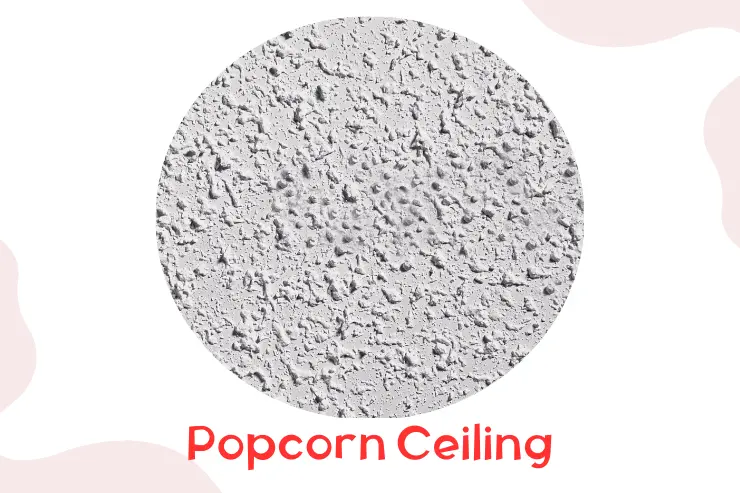A popcorn ceiling is a textured surface that looks bumpy, like plaster. People usually make it from joint compound or spray-on texture. It was once popular for its sound-blocking and easy installation, but now it is seen as outdated. They are hard to clean and can collect dust easily, which is why many people don’t like them anymore.
Why Does Popcorn Ceiling Exist?

Popcorn ceilings became popular in the 1950s and lasted until the 1980s. At the time, drop ceilings were a popular choice for finishing ceilings because they were quick and inexpensive. This was especially useful during the housing boom following World War II.
Even though there is debate now, people widely accepted them in the past. They helped builders cover up imperfections without much effort. People also used them in apartments and schools to reduce noise.
How Do they Look?
Popcorn ceilings are great for hiding imperfections in ceilings. When building a house, finishing a drywall ceiling is tricky. It involves covering seams with tape and joint compound, then sanding until smooth. This process, called taping and mudding, needs skill and can lead to uneven ceilings.
Adding a textured finish, such as popcorn, to your ceiling is a cost-effective and easy way to conceal flaws. This is particularly useful if you are working on the project yourself or have a tight budget. Additionally, popcorn ceilings reduce sound, making them ideal for busy areas like hallways and rooms with high ceilings.
What Caused Their Downfall?
A key material in mid-century popcorn ceilings was the impetus of their downfall. The original popcorn treatment contained asbestos, which researchers discovered was harmful to human health.
Asbestos is a mineral fiber found in nature. It can release into the air and cause health issues if breathed in or swallowed. MartinDelCampo explains that these health problems can include lung cancer.
But popcorn ceilings containing asbestos typically aren’t harmful unless disturbed. When damaged, crumbled, or removed, they can be unsafe. The Clean Air Act banned asbestos in all U.S. homes in the late 1970s. Manufacturers then started using small particles of vermiculite or polystyrene as a replacement for asbestos, according to DeLucia.
Still, the association these ceilings had with asbestos ultimately caused them to garner a negative reputation. They steadily declined in popularity after the ‘80s, and popcorn ceilings haven’t made a comeback since.
What about Asbestos?
Popcorn ceilings, also known as acoustic ceilings, used to contain asbestos. Asbestos was banned in 1978 because it posed health risks. The Clean Air Act was responsible for the ban.
The EPA advises against touching asbestos containing material that are in good condition. This is because they are not likely to be harmful to health.
After 1978, manufacturers made popcorn ceilings with safer materials like paper-based and styrofoam. They used asbestos in popcorn to contain asbestos because it resisted heat and corrosion. However, asbestos is no longer used in popcorn ceilings because of its health risks.
Should I Test for Asbestos in my Popcorn Ceilings?
Wondering if you should check for asbestos in your popcorn ceilings? If your ceiling was installed after the late 1980s, it likely does not contain asbestos. If your popcorn ceiling is in good shape, it’s safe to leave it as is.
If your ceiling is old and might have asbestos, testing is a good idea. You can’t tell if there’s asbestos just by looking at it or knowing its age. Testing is the only sure way to determine.
Although asbestos is usually safe if left alone, it can become dangerous if disturbed. Simple tasks like putting up hooks, cleaning, or even bumping into the ceiling can release harmful asbestos dust into the air.
Their Trend in Nowadays
Today, hardly anyone chooses popcorn ceilings for new homes built. Katherine Meyers, Design Manager at Guest House, says that people see them as outdated and that they can decrease your home’s value. “Most of my clients dislike them and want them removed,” adds MartinDelCampo. However, some still appreciate their unique style.
Popcorn Ceiling Removal
Popcorn ceilings had their moment in the past, but now, knockdown texture is more popular. Subtle and hides imperfections in the drywall.
Removing popcorn ceilings yourself is messy and risky. Hiring a professional like ROA Drywall can cost $1 to $2 per square foot. Alternatively, you could embrace the retro charm of popcorn ceilings and keep them.
So, why do we dislike them so much?
Popcorn ceilings aren’t everyone’s cup of tea. Critics often discuss the rough, bumpy texture of the surface. This texture affects how they look and also traps dust and stains. Over time, the dust and stains build up. Additionally, their uneven surfaces can create harsh shadows, making rooms feel smaller and less inviting.
How to Make the Best of Your Popcorn Ceiling?
Next time you face a dreaded popcorn ceiling, consider working with it rather than tearing it down. Your eyes (and lungs) might thank you.
Painting It:
Bright, even paint can transform the look of a popcorn ceiling. A fresh coat not only hides discoloration but also makes the surface less porous, reducing dust buildup.
Improving Lighting:
Swap out recessed lights for softer options like table and floor lamps. This minimizes harsh shadows, turning your popcorn ceiling into a subtle textural feature.
How ROA Drywall Can Help?
ROA Drywall specializes in removing outdated popcorn ceilings, which are known for trapping dust and stains and creating harsh shadows in rooms. Our professional team ensures safe and efficient removal, leaving behind a smooth surface ready for a modern finish. Say goodbye to popcorn ceilings and hello to a fresh, updated look with ROA Drywall’s affordable removal services.